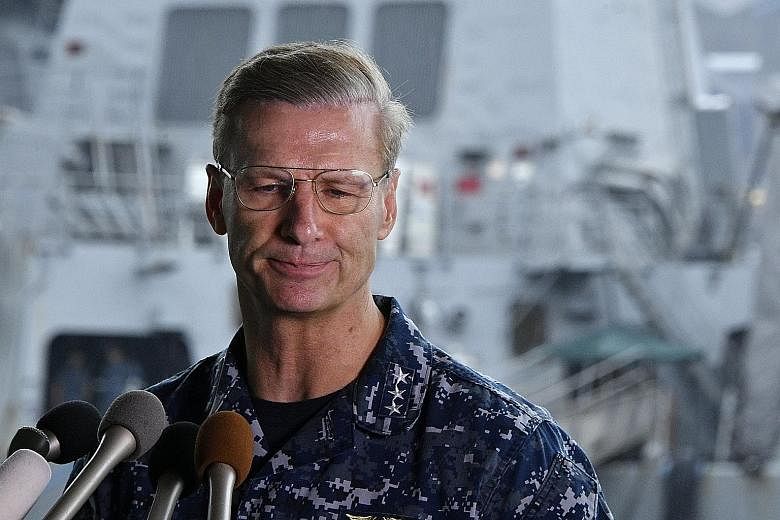WASHINGTON • The US Navy has dismissed the commander of its Seventh Fleet, Vice-Admiral Joseph Aucoin, due to "loss of confidence" in his ability to command, following a series of accidents at sea this year - two of which killed sailors.
Vice-Adm Aucoin was due to retire in about two weeks. Admiral Scott Swift, commander of the US Pacific Fleet, yesterday relieved him from his duties at the Seventh Fleet's Yokosuka base in Japan. The new commander is Rear-Admiral Phil Sawyer, who was slated to assume the post on Sept 7.
Monday's deadly collision of guided-missile destroyer USS John S. McCain with a heavier oil tanker off Singapore was the last straw. On June 17, another destroyer, USS Fitzgerald, was ripped open by a larger Japanese container ship.
Seven sailors were killed in the Fitzgerald disaster, and at least some of the 10 sailors reported missing from the McCain are dead.
Vice-Adm Aucoin had been the Seventh Fleet commander since September 2015, and was previously the deputy chief of naval operations for warfare systems. His removal is the highest profile in the US Navy since the disasters occurred.
The collisions have shocked the US Navy, where good seamanship and avoiding collisions are a fundamental expectation and demand.
Admiral John Richardson, the chief of naval operations, has ordered an "operational pause" across the globe in which commanders take a day or two each to make sure sailors understand the fundamentals of good seamanship. He also directed Admiral Phil Davidson of Fleet Forces Command to launch a separate review of the Seventh Fleet over the next few months to assess its culture, operations and readiness for missions.
Adm Swift, who oversees the Seventh Fleet as part of his role, expanded the scope of that scrutiny on Tuesday, ordering a second step to Adm Richardson's review that will include all US Navy forces in the Pacific.
It will include a "deliberate reset" for ships that focuses on navigation, maintaining mechanical systems and manning the ship's bridge appropriately, he said.
So far this year, the fleet has had four accidents. In May, a guided- missile cruiser collided with a South Korean fishing vessel. On Jan 31, another guided-missile cruiser ran aground in Tokyo Bay.
The fleet has about 50 to 70 ships assigned to it, including about a dozen at sea at any time. Its missions range from responding to natural disasters to countering North Korean threats and Chinese activities in the South China Sea.
"I think it is important to note that the Seventh Fleet is out there all the time, and it has been since World War II ended," said retired Vice-Admiral Peter Daly, chief executive of the US Naval Institute.
He and another Seventh Fleet veteran Scott Cheney-Peters also noted that years of the US Navy reducing its number of ships have taxed the crews on the remaining vessels, as the navy does more with less.
Still, the accidents - especially images of the McCain limping into Singapore - have prompted concern about a US Navy, the foremost symbol of America's power in the Asia- Pacific, in decline.
"It is good, of course, to fly the US flag in the region," said Emeritus Professor Carlyle Thayer of the University of New South Wales, an expert on regional security issues. "But one picture is worth a thousand words, and this picture was of a high-publicity vessel in a very bad way. Perception-wise, that is huge."
WASHINGTON POST, NYTIMES

